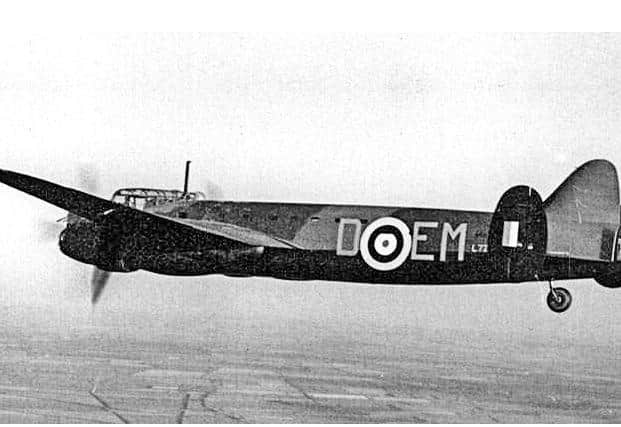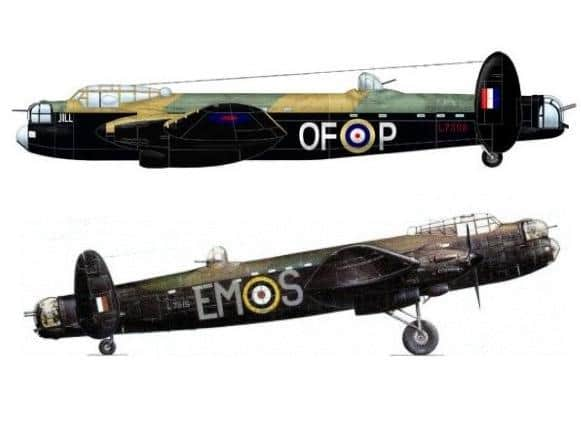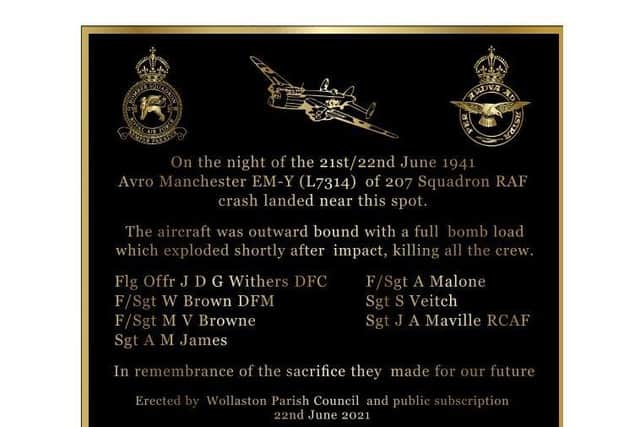Wollaston bomber crash “The Avro Manchester the legend behind the Lancaster”
and live on Freeview channel 276
A sad end to an English summer day
June 21, 1941 was a warm and sunny English summer day. The previous few weeks had been windy and wet with low temperatures, more akin to spring than the onset of summer but all that was to change for the crew of Avro Manchester L7314.
The Avro Manchester bombers of 207 Squadron RAF sat on their dispersals at RAF Waddington, South West of Lincoln. The crews had finished a light supper and had then been transported to the aircraft that had been recently inspected by their ground crews and fully 'bombed up'.


Advertisement
Hide AdAdvertisement
Hide AdThe sky was not yet dark, after all it was the longest day, and the outside temperature was warm, but the experienced crews made sure that they were warmly dressed and had all the personal equipment they would need for the flight, before climbing into the trucks which would take them to the dispersal area and their aircraft.
The crews climbed into their individual aircraft, the crew of Avro Manchester L7314 (Y), led by their youthful skipper Flying Officer Jackie Withers. Just after 01.00 am on the morning of the 22nd June 1941, the still of the night was shattered by the noise of 14 Rolls Royce Vulture engines as the seven Manchesters of 207 squadron rolled along the taxiway to the main runway and line astern took off into the darkening sky.
The target tonight for No 5 Bomber Group was Boulogne, and seven Manchester bombers of 207 squadron were tasked along with crews from 97 and 61 squadrons, with the attack on the port and shipping in the harbour.
There was a waning moon that night, perfect for a bomber offensive, and after a miserable introduction to service life, Bomber Command had decided on a target well within the range of the Avro Manchester aircraft and should have been a straightforward “milk run” and a morale boost for the crews.


Advertisement
Hide AdAdvertisement
Hide AdFlying Officer Withers was 21 years old, a contemporary of Guy Gibson, he joined 83 squadron at RAF Scampton when Gibson was a Flight Commander, was an experienced bomber pilot for all his youth, was outbound on track at around 6000 feet, German aircraft were active over Lincolnshire and one, which was being tracked by the Lincolnshire Air Observer Corps, by chance, followed a course overlapping that of L7314 (Y).
No 10 Group Fighter Command had scrambled a number of night fighters, including airborne interception radar-equipped Bristol Beaufighters from 25 squadron at RAF Wittering to counter the threat posed by the German intruders. The Fighter Controller at 10 Group was homing one of these aircraft along the presumed track of the intruder and when the two tracks crossed the Beaufighter was mistakenly homed onto the track of L7314 (Y).
In addition to this mischance, another was to contribute to the events of the next few minutes. No 5 Group’s operations plan for the night, giving times and routes etc. had gone via Bomber Command to Fighter Command, arriving at 10 Group Headquarters just at the time of the change of controllers.
The new controller had received the operations plan, but it had become covered by other papers on his desk and the details within it had not been extracted and placed on the operations board. Consequently the controller had no information before him to indicate the presence of friendly aircraft at the vital location. Accordingly, the controller homed the fighter onto the ‘hostile’ until, in the darkness, the pilot was able to gain a visual on the aircraft ahead.


Advertisement
Hide AdAdvertisement
Hide AdSquadron personnel believe that what happened next was that the Beaufighter pilot identified the aircraft as an RAF bomber and relayed this to the controller, who was unwilling to accept this identification. Cautiously, the Beaufighter moved closer, recognising roundel markings and RAF squadron codes in pale letters on the fuselage. The bomber crew had also seen the fighter for they fired off the correct codes of the day. This was passed to the ground station, where the controller still insisted that the aircraft was a hostile and instructed the pilot to complete the interception and shoot the aircraft down.
Although in two minds, the Beaufighter pilot dropped back before finally closing in again beneath the Manchester, still flying slowly and straight and level, and giving it a burst with the fixed forward cannon and machine guns.
Shards of Perspex from the Manchester, along with a Perspex dome and an airman’s glove were found in a field by Crow Hill Farm near Irthlingborough. This debris hint at damage in the cockpit area. Further fragments were found in the playground of College Street School in Irthlingborough itself. A second burst of fire was seen by observers on the ground as Withers overflew Chester House on the A45, leading to the Manchester catching fire.
Flying Officer Withers had no time to jettison bombs or fuel, and none of the crew escaped by parachute. The captain then accomplished an exemplary belly landing in a field at Lovett’s Farm just to the east of Shepherds Hill in Wollaston at about 01.55 am. Several crew members began scrambling from the burning wreck but unfortunately part of the bomb load exploded and no-one survived.
Advertisement
Hide AdAdvertisement
Hide AdThe next day only traces of five separate bodies and the identity disc of Sergeant James the second pilot, could be found in the burnt out wreckage of L7314 (Y). This tragedy took the lives of Flying Officer J D G Withers, Sergeant A M James, Sergeant W Brown DFM, Sergeant A Malone, Sergeant S Veitch, Sergeant M V Browne and Sergeant J A Maville RCAF.
It was a tragic mistake which should never have happened and for which safeguards were in place, yet under the stress of war, such human errors were likely. It was no consolation to the crew of L7314 (Y) that the crew of the Beaufighter Pilot Officers Smith and Lusty were later Court Martialled and a portion of the blame was also allocated to the ground station.
Finally, on the same night a German Ju88 intruder was shot down by a 25 squadron Beaufighter near Market Deeping.
Lindsay Alvis
A memorial to the seven airmen will be unveiled on the 80th anniversary of the accident.
Read about the memorial here: Wollaston victims of Second World War 'friendly fire' bomber crash memorial